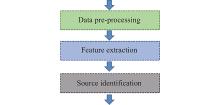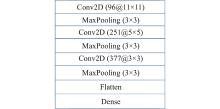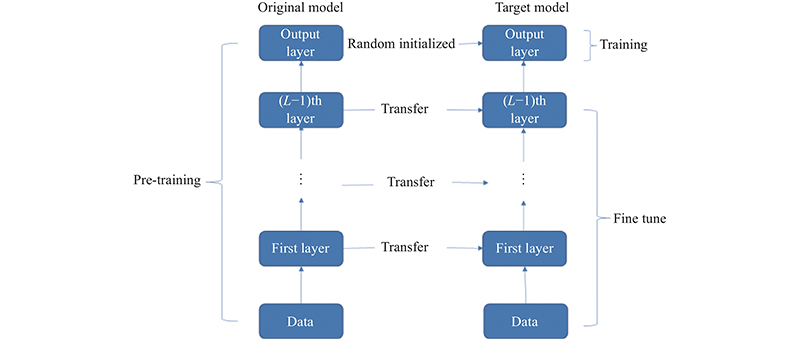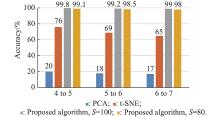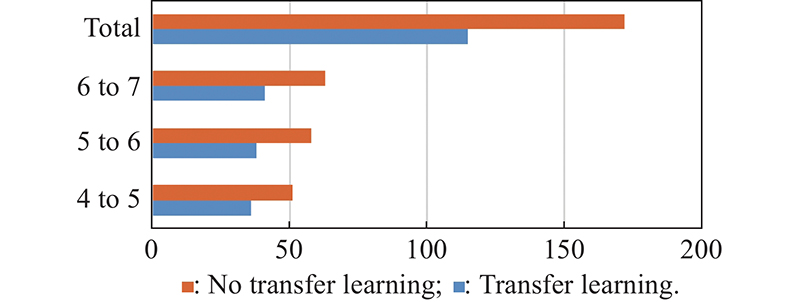| 1 |
LANGLEY L E Specific emitter identification (SEI) and classical parameter fusion technology. Proc. of the Conference on Western Electronic Show and Convention, 1993, 377- 381.
|
| 2 |
TALBOT K I, DULEY P R, HYATT M H Specific emitter identification and verification. Technology Review Journal, 2003, 113, 113- 133.
|
| 3 |
CIRESAN D, MEIER U, SCHMIDHUBERJ Multi-column deep neural networks for image classification. Proc. of the IEEE Conference on Computer Vision and Pattern Recognition, 2012, 3642- 3649.
|
| 4 |
JI S W, XU W, YANG M, et al 3D convolutional neural networks for human action recognition. IEEE Trans. on Pattern Analysis & Machine Intelligence, 2013, 35 (1): 221- 231.
|
| 5 |
BENGIO Y, COURVILLE A, VINCENT P Representation learning: a review and new perspectives. IEEE Trans. on Pattern Analysis & Machine Intelligence, 2013, 35 (8): 1798- 1828.
|
| 6 |
DONG C, LOY C C, HE K, et al Image super-resolution using deep convolutional networks. IEEE Trans. on Pattern Analysis Machine Intelligence, 2016, 38 (2): 295- 307.
doi: 10.1109/TPAMI.2015.2439281
|
| 7 |
ZHANG K, ZUO W M, CHEN Y J, et al Beyond a Gaussian denoiser: residual learning of deep CNN for image denoising. IEEE Trans. on Image Processing, 2017, 26 (7): 3142- 3155.
doi: 10.1109/TIP.2017.2662206
|
| 8 |
KRIZHEVSKY A, SUTSKEVER I, HINTON G ImageNet classification with deep convolutional neural networks. Proc. of the Conference on Neural Information Processing Systems, 2012, 1097- 1105.
|
| 9 |
SIMONYAN K, ZISSERMANA Very deep convolutional networks for large-scale image recognition. Proc. of the Conference on Computer Science, 2014, 9, 1032- 1048.
|
| 10 |
HE K M, ZHANG X Y, REN S Q, et al Deep residual learning for image recognition. Proc. of the IEEE Conference on Computer Vision and Pattern Recognition, 2016, 770- 778.
|
| 11 |
ABDULATIFS, WEI Q, AZIZ F, et al Micro-Doppler based human-robot classification using ensemble and deep learning approaches. Proc. of the IEEE Conference on Radar, 2018, 1043- 1048.
|
| 12 |
FURUKAWA H Deep learning for endtoend automatic target recognition from synthetic apertureradar imagery. IEICE Technical Report, 2018, 117 (403): 35- 40.
|
| 13 |
PAN Y W, YANG S H, PENG H, et al Specific emitter identification based on deep residual networks. IEEE Access, 2019, 7, 54425- 54434.
doi: 10.1109/ACCESS.2019.2913759
|
| 14 |
BALDINI G, GIULIANI R An assessment of the impact of wireless interferences on IoT emitter identification using time frequency representations and CNN. Proc. of the Conference on Global IoT Summit, 2019, 1- 6.
|
| 15 |
DING L D, WANG S L, WANG F G, et al Specific emitter identification via convolutional neural networks. IEEE Communications Letters, 2018, 22 (12): 2591- 2594.
doi: 10.1109/LCOMM.2018.2871465
|
| 16 |
WONG L J, HEADLEY W C, MICHAELS A J Specific emitter identification using convolutional neural network-based IQ imbalance estimators. IEEE Access, 2019, 7, 33544- 33555.
doi: 10.1109/ACCESS.2019.2903444
|
| 17 |
ZHANG G Q, DONG Y Z, LIU P X Classification of low probability of interception communication signal modulations based on time-frequency analysis and artificial neural network. Proc. of the International Conference on Electronics, Communications and Control, 2011, 1936- 1939.
|
| 18 |
CHEN S L, XIE F Y, CHEN Y, et al Identification of wireless transceiver devices using radio frequency (RF) fingerprinting based on STFT analysis to enhance authentication security. Proc. of the IEEE 5th Conference on International Symposium on Electromagnetic Compatibility, 2017, 1- 5.
|
| 19 |
CHAPELLE O, SCHÖLKOPF B, ZIEN A. Introduction to semi-supervised learning. THOMAS D. ed. Semi-supervised learning, Cambridge: MIT Press, 2006.
|
| 20 |
CHAPELLE O, BERNHARD S, ZIEN A. Low-density separation. THOMAS D. ed. Semi-supervised learning, Cambridge: MIT Press, 2006.
|
| 21 |
DABIRI S, LU C, HEASLIP K, et al Semi-supervised deep learning approach for transportation mode identification using GPS trajectory data. IEEE Trans. on Knowledge and Data Engineering, 2020, 32 (5): 1010- 1023.
doi: 10.1109/TKDE.2019.2896985
|
| 22 |
ZHANG C L, ZHANG Q, HANSENJ H L Semi-supervised learning with generative adversarial networks forarabic dialect identification. Proc. of the IEEE International Conference on Acoustics, Speech and Signal Processing, 2019, 5986- 5990.
|
| 23 |
LI K, ZHANG J Y, FANG Z W Communication emitter identification based on kernel semi-supervised discriminant analysis. Proc. of the IEEE International Conference on Power, Intelligent Computing and Systems, 2019, 98- 101.
|
| 24 |
BAI X J, ZHANG L, YANG T, et al. Semi-supervised learning based acoustic NLOS identification for smartphone indoor positioning. Proc. of the IEEE International Conference on Signal Processing, Communications and Computing, 2019: 1–6. DOI: 10.1109/ICSPCC46631.2019.8960779.
|
| 25 |
O’SHEA T J, WEST N, VONDAL M, et al Semi-supervised radio signal identification. Proc. of the 19th International Conference on Advanced Communication Technology, 2017, 33- 38.
|
| 26 |
ZHANG K, LAN L, KWOK J T, et al Scaling up graph-based semisupervised learning via prototype vector machines. IEEE Trans. on Neural Networks and Learning Systems, 2015, 26 (3): 444- 457.
doi: 10.1109/TNNLS.2014.2315526
|
| 27 |
LEE D H Pseudo-label: the simple and efficient semi-supervised learning method for deep neural networks. Proc. of the Conference on ICML Workshop: Challenges in Representation Learning, 2013, 1- 6.
|
| 28 |
MALMGREN-HANSEN D, KUSK A, DALL J, et al Improving SAR automatic target recognition models with transfer learning from simulated data. IEEE Geoscience and Remote Sensing Letters, 2017, 14 (9): 1484- 1488.
doi: 10.1109/LGRS.2017.2717486
|
| 29 |
LANG H T, WU S W, XU Y J Ship classification in SAR images improved by AIS knowledge transfer. IEEE Geoscience and Remote Sensing Letters, 2018, 15 (3): 439- 443.
doi: 10.1109/LGRS.2018.2792683
|
| 30 |
WANG Y Y, WANG C, ZHANG H. Combining single shot multibox detector with transfer learning for ship detection using sentinel-1 images. Proc. of the Conference on SAR in Big Data Era: Models, Methods and Applications, 2017: 1–4. DOI: 10.1109/BIGSARDATA.2017.8124924.
|
| 31 |
ZHANG W, ZHU Y F, FU Q Semi-supervised deep transfer learning-based on adversarial feature learning for label limited SAR target recognition. IEEE Access, 2019, 7, 152412- 152420.
doi: 10.1109/ACCESS.2019.2948404
|
| 32 |
KAMSING P, TORTEEKA P, YOOYENS Deep convolutional neural networks for plane identification on satellite imagery by exploiting transfer learning with a different optimizer. Proc. of the IEEE International Conference on Geoscience and Remote Sensing Symposium, 2019, 9788- 9791.
|
| 33 |
TU X, LAI K, YANUSHKEVICH S Transfer learning on convolutional neural networks for dog identification. Proc. of the IEEE 9th International Conference on Software Engineering and Service Science, 2018, 357- 360.
|
| 34 |
LISTYALINAL, MUSTIADI I Accurate and low-cost fingerprint classification via transfer learning. Proc. of the 5th International Conference on Science in Information Technology, 2019, 27- 32.
|
| 35 |
DU H, HE Y, JIN T. Transfer learning for human activities classification using micro-Doppler spectrograms. Proc. of the IEEE International Conference on Computational Electromagnetics, 2018: 1–3. DOI: 10.1109/COMPEM.2018.8496654.
|
 ), Hao ZHANG(
), Hao ZHANG( ), Houjun WANG(
), Houjun WANG( ), Zhengyang GUO(
), Zhengyang GUO( )
)
